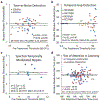Nicotine enhances auditory processing in healthy and normal-hearing young adult nonsmokers
- PMID: 31832719
- PMCID: PMC7039769
- DOI: 10.1007/s00213-019-05421-x
Nicotine enhances auditory processing in healthy and normal-hearing young adult nonsmokers
Abstract
Rationale: Electrophysiological studies show that systemic nicotine narrows frequency receptive fields and increases gain in neural responses to characteristic frequency stimuli. We postulated that nicotine enhances related auditory processing in humans.
Objectives: The main hypothesis was that nicotine improves auditory performance. A secondary hypothesis was that the degree of nicotine-induced improvement depends on the individual's baseline performance.
Methods: Young (18-27 years old), normal-hearing nonsmokers received nicotine (Nicorette gum, 6mg) or placebo gum in a single-blind, randomized, crossover design. Subjects performed four experiments involving tone-in-noise detection, temporal gap detection, spectral ripple discrimination, and selective auditory attention before and after treatment. The perceptual differences between posttreatment nicotine and placebo conditions were measured and analyzed as a function of the pre-treatment baseline performance.
Results: Nicotine significantly improved performance in the more difficult tasks of tone-in-noise detection and selective attention (effect size = - 0.3) but had no effect on relatively easier tasks of temporal gap detection and spectral ripple discrimination. The two tasks showing significant nicotine effects further showed no baseline-dependent improvement.
Conclusions: Nicotine improves auditory performance in difficult listening situations. The present results support future investigation of nicotine effects in clinical populations with auditory processing deficits or reduced cholinergic activation.
Keywords: Acetylcholinergic systems; Auditory processing; Nicotine; Selective attention; Spectral ripple discrimination; Temporal gap detection; Tone in noise detection.
Conflict of interest statement
Conflicts of interest
F.G.Z. owns stock in Axonics, Nurotron, Syntiant and Velox Biosystems. The other authors declare no competing interests.
Figures


Similar articles
-
Task-dependent effects of nicotine treatment on auditory performance in young-adult and elderly human nonsmokers.Sci Rep. 2021 Jun 23;11(1):13187. doi: 10.1038/s41598-021-92588-z. Sci Rep. 2021. PMID: 34162968 Free PMC article.
-
Nicotine enhances automatic temporal processing as measured by the mismatch negativity waveform.Nicotine Tob Res. 2009 Jun;11(6):698-706. doi: 10.1093/ntr/ntp052. Epub 2009 May 12. Nicotine Tob Res. 2009. PMID: 19436039 Clinical Trial.
-
Systemic Nicotine Increases Gain and Narrows Receptive Fields in A1 via Integrated Cortical and Subcortical Actions.eNeuro. 2017 Jun 22;4(3):ENEURO.0192-17.2017. doi: 10.1523/ENEURO.0192-17.2017. eCollection 2017 May-Jun. eNeuro. 2017. PMID: 28660244 Free PMC article.
-
Modulation of auditory deviance detection by acute nicotine is baseline and deviant dependent in healthy nonsmokers: a mismatch negativity study.Hum Psychopharmacol. 2014 Sep;29(5):446-58. doi: 10.1002/hup.2418. Epub 2014 Jul 9. Hum Psychopharmacol. 2014. PMID: 25196041 Clinical Trial.
-
Visual and auditory alertness: modality-specific and supramodal neural mechanisms and their modulation by nicotine.J Neurophysiol. 2007 Apr;97(4):2758-68. doi: 10.1152/jn.00017.2007. Epub 2007 Feb 7. J Neurophysiol. 2007. PMID: 17287445
Cited by
-
Task-dependent effects of nicotine treatment on auditory performance in young-adult and elderly human nonsmokers.Sci Rep. 2021 Jun 23;11(1):13187. doi: 10.1038/s41598-021-92588-z. Sci Rep. 2021. PMID: 34162968 Free PMC article.
-
α3β4∗ Nicotinic Acetylcholine Receptors Strongly Modulate the Excitability of VIP Neurons in the Mouse Inferior Colliculus.Front Neural Circuits. 2021 Aug 9;15:709387. doi: 10.3389/fncir.2021.709387. eCollection 2021. Front Neural Circuits. 2021. PMID: 34434092 Free PMC article.
-
Cholinergic modulation of sensory perception and plasticity.Neurosci Biobehav Rev. 2023 Sep;152:105323. doi: 10.1016/j.neubiorev.2023.105323. Epub 2023 Jul 17. Neurosci Biobehav Rev. 2023. PMID: 37467908 Free PMC article. Review.
-
Effects of nicotine-alcohol co-use on alcohol-induced blackouts and other alcohol-related consequences in college students.Psychopharmacology (Berl). 2025 Jun 10:10.1007/s00213-025-06830-x. doi: 10.1007/s00213-025-06830-x. Online ahead of print. Psychopharmacology (Berl). 2025. PMID: 40493073
-
Alpha-2 nicotinic acetylcholine receptors regulate spectral integration in auditory cortex.Front Neural Circuits. 2024 Nov 1;18:1492452. doi: 10.3389/fncir.2024.1492452. eCollection 2024. Front Neural Circuits. 2024. PMID: 39553292 Free PMC article.
References
-
- Behler O, Breckel TP, Thiel CM (2015) Nicotine reduces distraction under low perceptual load. Psychopharmacology (Berl) 232: 1269–77. - PubMed
-
- Benowitz NL, Lessov-Schlaggar CN, Swan GE, Jacob P 3rd (2006) Female sex and oral contraceptive use accelerate nicotine metabolism. Clin Pharmacol Ther 79: 480–8. - PubMed
Publication types
MeSH terms
Substances
Grants and funding
LinkOut - more resources
Full Text Sources
Medical
Miscellaneous

